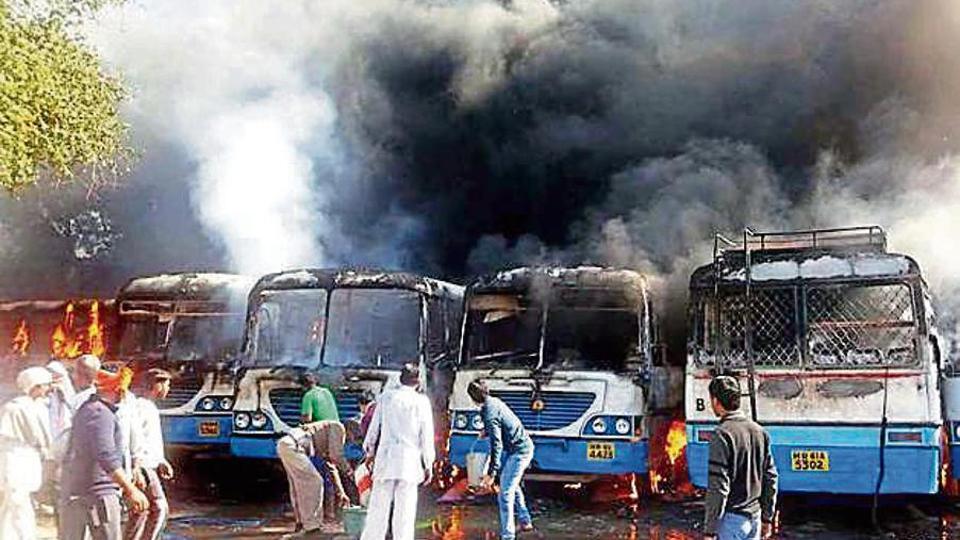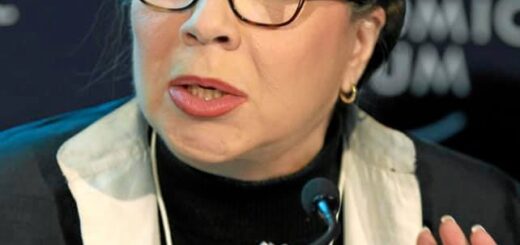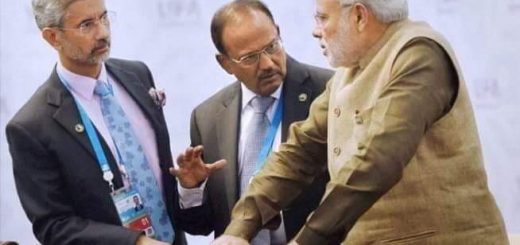Caste: The Achilles Heel of India – Krishan Tyagi

During the recent state assembly elections in Gujarat (December 2017) the Congress party leader Rahul Gandhi not only declared himself to be a ‘devotee of Shiva’ and a jane-u-dhaari (sacred-thread bearing, meaning staunch believer, orthodox) Hindu, he also picked up three disparate elements from the body politic of Gujarat – a so-called Dalit activist Jignesh Mevani, a so-called OBC activist Alpesh Thakur, and a self-styled Patidar leader Hardik Patel. All these three “young leaders” emerged on the scene of Gujarat politics by starting agitations to demand reservations in jobs and other amenities for their own castes. Apart from “impressing” the people of Gujarat with his new avatar as jane-u-dhaari Hindu, newly appointed Congress party president Rahul Gandhi’s politics in Gujarat revolved around ‘Caste’. While giving assurance of more favourable treatment to the so-called “Dalits” (a term used for former untouchable castes, literally meaning ‘the oppressed’) and “Other Backward Castes (OBCs)”, Rahul Gandhi offered the lollipop of ‘reservation in jobs’ to the most dominant caste of Gujarat – Patidars/Patels.
And, the strategy worked to a great extent. The party nearly won the elections. In the state legislative assembly, the party and its alliance partners now occupy 81 seats, quite close to the half-way mark of 91 seats. Realising the potential strength of the strategy adopted by the Congress party, PM Modi spent days campaigning in Gujarat in Gujarati (quite uncharacteristic of NaMo), had to raise the question of Gujarati pride (His being called ‘Neech’ meaning ‘low person’ by a Congress politician was an insult to all Indians who elected him as the PM, but Narendra Modi kept it associated with Gujaratis only – ‘Isn’t it an insult of Gujaratis?, he asked). In other words, Rahul Gandhi’s strategy to divide Gujaratis on caste-lines made nationally popular Prime Minister Narendra Modi jump through hoops to scrape through the state assembly elections in his own home state!
Had the Congress party won the Gujarat elections, where would the state be today! By this time the claims and counter-claims of backwardness and the degrees of backwardness of various Castes would have overwhelmed the Gujarat government.
And what implications the reservations for Patels in Gujarat would have for other states! Marathas in Maharashtra, Reddys and Kammas in AP, Lingayats in Karnataka, and Vanniyars in Tamil Nadu would have been up in arms demanding immediate OBC status for themselves.
Where would caste-based reservations take the country to! This formula of providing “social justice”, invented by Indian politicians, took the country to a near civil war between “Backwards” and “Forwards” in the early 1990s. More recently, in February 2016 during the agitation to get Jats included in the OBCs, the largescale violence against the public property and other communities paralysed the state of Haryana for 10 days. National highways and trains were blocked. Several incidents of inter-caste violence, particularly against the small Saini and Punjabi communities, took place across Haryana. There were reports of mass rapes of women travelling through the state. The agitation was estimated to have caused a loss of ₹340 billion (US$5.3 billion) in northern India. And, according to the Haryana Police 30 people got killed and over 200 people were injured in the agitation.
Caste is a divisive, dangerous and destructive force.
Yet, caste has been the curse of Indian society for a long time. The so-called upper castes inflicted indignities on the former “untouchables” under the Varna Vyavastha (CasteSystem) for many hundreds, if not thousands, of years. Some people still harbour caste prejudices. Nearly seven decades after caste untouchability was abolished by the Constitution of India, more than a fourth of Indians say they continue to practise it in some form in their homes. A survey conducted in over 42,000 households across India by the National Council of Applied Economic Research (NCAER) and the US University of Maryland in 2011-12 found that 27 percent of Indians still practice caste untouchability.
And the incidents of caste repression and violence against the so-called lower caste people happen even today. According to the National Crime Records Bureau (NCRB), 47,064 cases of crimes against Dalits – ranging from rape, murder, beatings, and violence related to land matters – were registered in 2014.
However, the caste narrative is not linear. It is not just the people from the socalled upper castes who harbour caste prejudices; the “victims” have internalised and perpetuated caste system too. In northern India, Chamars have been the victims of caste discrimination and repression at the hands of the socalled upper castes. And, they in turn have considered themselves superior to Balmikis. According to the above quoted survey, not only the practice of caste untouchability was prevalent among the so-called upper castes, 15 per cent of Scheduled Caste (Dalits) and 22 per cent of Scheduled Tribe respondents admitted to the practice against whom they considered “even more lower castes”!
Also, while some people suffer caste repression, others from “the disadvantaged communities” reap political and economic benefits from it. The organisation of political parties on caste lines such as RJD, SP and BSP shows a big section of politicians thrives on the caste divisions in the society. One unfortunate incident of assault against Dalits in Una in Gir Somnath district made Jignesh Mewani become a new Dalit leader overnight. Mayawati became chief minister of Uttar Pradesh, the largest state of India, four times primarily through playing the Dalit card. As the most important Dalit leader in present times, Mayawati received presents from her followers worth hundreds of crores on her birthdays. A good number of well-off Dalits, sometimes three to four generations of the same family, who have never suffered a social impediment themselves, have benefitted from caste-based reservations in jobs and promotions. Senior civil service officers and university professors benefitting from castebased reservations, who claim their own children need reservations in jobs, display a clear vested interest in the perpetuation of Caste. In fact, this section of the socalled Dalits is deep down quite happy to see some caste atrocities taking place in remote areas so that that can be forwarded as justification for reservation in jobs for themselves. In South Africa too, there were some sections of the Black population who benefitted from the Apartheid.
Many corrupt and dishonest people occupy high places in the body politic of India due to casteism. Convicted criminals get elected to state legislative assemblies and Indian parliament because of people’s caste allegiance towards them. Many dishonest Indian politicians believe that even if they are found out and convicted for corruption, they can get re-elected because their caste fellows would still vote for them. And there is no point in pretending otherwise. A large number of Indian electorate ignores the corruption indulged in by politicians coming from their castes. Lalu Prasad Yadav is a prime example of that. A many-times convicted criminal Lalu Prasad, whose whole family is now being probed for corrupt deals, is still ruling the roost in Bihar because his caste folk still vote for him. Lalu Prasad is not the only one. The country is full of people who are known to be corrupt, and yet a huge number of their caste fellows support them. Casteism is largely responsible for dishonesty and corruption in the government administration of the country.
Like racism, Caste severely damages people’s lives at individual level and badly weakens the society. As quoted by Richard Wilkinson and Kate Picket in their book, The Spirit Level: Why Greater Equality Makes Societies Stronger, in 2004, World Bank economists Karla Hoff and Priyanka Pandey reported the results of a remarkable experiment. They took 321 high-caste and 321 low-caste 11 to 12 year old boys from scattered rural villages in India, and set them the task of solving mazes. First, the boys did the puzzles without being aware of each other’s caste. Under this condition the low-caste boys did just as well with the mazes as the high-caste boys, indeed slightly better. Then, the experiment was repeated, but this time each boy was asked to confirm an announcement of his name, village, father’s and grandfather’s names, and caste. After this public announcement of caste, the boys did more mazes, and this time there was a large caste gap in how well they did – the performance of the low-caste boys dropped significantly. The same phenomenon has been demonstrated in experiments with white and black high-school students in America, most convincingly by social psychologists Claude Steele at Stanford University, and Joshua Aronson at New York University. In one study they administered a standardized test used for college students’ admission to graduate programmes. In one condition, the students were told that the test was not a measure of ability; and in the second condition, the students were told that the test was a measure of ability. The white students performed equally under both conditions, but the black students performed much worse when they thought their ability was being judged. Steele and Aronson labelled this effect ‘stereotype threat’ and it has now been shown that it is a general effect, which applies to sex differences as well as racial and ethnic differences.
Commenting on the experiments, Richard Wilkinson and Kate Picket write, ‘This is striking evidence that performance and behaviour in an educational (and employment) situation can be profoundly affected by the way we feel we are seen and judged by others. When we expect to be viewed as inferior, our abilities seem to be diminished.’
The politicians supporting the recognition of caste in the public sphere do no good to the communities whose interests they claim to champion. People from those communities are subjected to a psychological onslaught by their own leaders and other do-gooders. People are told day and night that ‘because you’re born in this and this community, you can never be equal to people born in that and that community.’ The feeling of ‘inferiority’ is inculcated which leads to low selfesteem. And, lower expectation from a section of society becomes a universal belief. “Progressive and socialist” politicians give them a special treatment and television anchors handle them with kid gloves. Quite healthy, well-to-do and normal people are treated as ‘special needs cases’. People are forced to live in psychological complexes all their life.
The Indian society has become so conditioned that people are living the belief that they are born “inferior”. This is not healthy for the society or the state.
For a healthy society and for the survival of a State, a feeling of equality among its citizens is paramount – if any section of citizens feels it is being discriminated against at the social level or by the State, the system would break down one day or the other.
The system devised by Indian politicians to counter the maleficent effect of Caste and to achieve “social justice” is Caste-based Reservations in jobs and educational institutions. The Caste-based Reservations system superimposes itself on the caste discriminations in the society. Thus the discrimination operates at two levels now – reinforcing each other. As the Caste-system punished people on the basis of their birth in a particular family, over which no one has any control, so does the State operated Caste-based Reservations system. This system is basically an inverse image of the Caste-system, and is even more inimical to equality since it is operated by the State.
There was a justification for reservation on the basis of caste for former untouchables for a limited time, when this section of the society was almost universally socially segregated and faced Apartheid like conditions. Today the situation is very different, and caste is no longer the criterion with which people’s social status is determined. No one in the Indian society would now accord a higher social status to a so-called Brahman working as a peon in an office or a Rajput working as a porter at a railway station compared to a high ranking bureaucrat coming from a Dalit family. How could the State say that all Dalits face the same social impediment as they did in 1950, when the system of reservations was introduced, and all the people from the so-called upper castes are in advantageous positions!
And, what are OBCs? Who suppressed Jats, Yadavs and Gurjars? They are Kshatriyas. Lodh-Rajputs are supposed to be high caste Kshatriyas. Where is the social impediment that these communities have suffered! Anyone who is familiar with how the Caste-system operates in Indian villages would know that the village has a dominant land owning, agriculturist community supported by subsidiary communities/families such as badhi (carpenter), luhaar (ironsmith), kumhaar (potter), dhobi (washer man), julaaha (weaver), darji (tailor), naai (barber), baman/brahman (priest), bania (shopkeeper) and former untouchables, who were generally landless workers. Jats, Rajputs, Marathas, Yadavs, Patels and Gurjars are the dominant, land owning communities in North India. They all know it well. In the society they domineer by calling themselves Chaudhari and Thakur (meaning, lords of the villages) and before the government they claim to be “backward”! In fact these dominant communities are the main classes who have committed excesses against the former untouchables. Many reports have shown Yadavs (UP and Bihar) Jats (Western Uttar Pradesh and Haryana) and Gurjars (Rajasthan) to be the main perpetrators in northern India in the past. Today they are demanding reservations for themselves! The perpetrators of injustice are claiming to be victims of injustice! To begin with, the leaders of the casteist Samajwadi Party played the biggest fraud on genuinely backward communities by getting their own dominant Yadav caste included in the category of OBCs. They were then joined in this deception by leaders of other powerful communities such as Lodh Rajputs. Lately the inclusion of Tyagis, who are a landed class among Brahmans, into the category of OBCs in the state of Haryana, a byproduct of the Jat agitation, finally shows that OBCs is the most bogus category of people being provided reservations in jobs. Are Tyagis poorer than non-Tyagi Brahmans! If anything it is the other way. Who are these “bodies” adjudging the eligibility of a community to be included in the OBCs! Or is it not simply whoever is able to bully the government by blocking roads and trains and by indulging in violence against public property gets the status of OBC!
India has been on the wrong path since VP Singh threw down the gauntlet of Mandal Commission recommendations to checkmate his deputy Devi Lal in 1990 (Political analysts believe, had Devi Lal not rebelled, VP Singh would have never come up with that idea), and as Sahir Ludhianvi said ‘Dard ka had sei badh jaana hai dawaa ho jaanaa (meaning, when the pain crosses its limits, it becomes a remedy), inclusion of Tyagis in the list of OBCs proves how ridiculous and unfair this approach is. The so-called OBCs represent the travesty of the system meant to deliver ‘social justice’! The caste consciousness that was on the decline for four and half decades in the Independent India has been successively increasingly since the introduction of OBCs into the system.
The system devised by the Indian State is basically an antithesis to equality.
If you ask a so-called upper caste person, ‘Why don’t you treat people from the so-called lower castes equally? And their answer is – ‘If they compete with me equally, I would accept them equal. If they don’t, how could they be considered equal?’
So, the proponents of Caste-based Reservations should know, as long as there is caste-based reservation system, achieving a caste-less society or caste equality is out of the question. Some of them argue, “Oh, equality does not mean you treat ‘unequals’ equally. ‘Unequals’ have to be treated unequally.” Well then within the castes also there are inequalities – there is a huge range of economic and social inequalities in the so-called Dalit communities as it is in the so-called upper castes. The children of Ram Vilas Paswan and those of a Dalit construction worker aren’t exactly ‘Equals’ either. The question is – ‘What Unequals’ are to be matched with ‘What Unequal’ treatment’ in ‘What Situations’? A huge number of matrices showing ‘different treatment’ to ‘different unequals’ in ‘different situations’ would be needed – dividing the whole of Indian society into three or four categories would not suffice. Following that argument, until all those matrices are prepared and executed, equality cannot be claimed to be achieved.
No matter what way we look at it, the system of caste-based reservations devised by Indian politicians has not delivered equality. The system has reached the stage where it is unjust to many born in the so-called upper castes who also suffer from economic and social impediments (this feeling lies at the base of Jat, Patel and Maratha agitations), and cheats those among the ‘reserved categories’ who are really weak and deserve help. Those who insist on continuing it are actually accepting that despite operating the Castebased Reservations for seven decades, social inequalities still remain. The socalled upper castes jumping into the fray demanding reservations for themselves only shows increasing caste conflicts and the old divisions in the society becoming worse.
Caste is a complex phenomenon and it has been made more and more complicated by short-sighted and selfish politicians, out to gain power no matter what the cost to the society. But one thing is definite – Caste is holding India back and no one particular section of the society can be entirely blamed for the malaise India is in.
The State of India needs to review its 70 year old policy to achieve social justice through caste-based reservations. Furthermore, every reservation system – whether based on race, caste, gender or income – does need to be balanced against the loss of efficiency it leads to. Therefore, India very seriously needs to look at how other countries have solved the problem of social and racial inequities in their societies. After all, the word “caste” comes from the Portuguese language! There has been “Serfdom” in Europe and “Slavery” in the US, and they have resolved those problems long ago. As this author mentioned in a previous article Racism in India, in Britain a great level of racial equality has been achieved in a span of 30 to 40 years without any reservations in jobs.
To develop as a modern society, India must tackle the issue of Caste RATIONALLY. People have no control over where they are born. They are citizens of India, and the Constitution of India at one time did guarantee the dignity of individual, without any discrimination on the basis of caste, creed and colour. Government and society both need to work to have equality at all levels of life.
Otherwise, as this author wrote before, no country has got a divine right to remain united and progress for ever. Religion divided India; Caste could destroy it.
Copyright © 2018 Krishan Tyagi. All Rights Reserved.
This article has also been published in India Link International, Apr–May 2018Caste
The Achilles Heel of India
By Krishan Tyagi





